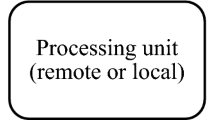Abstract
The many disadvantages of traditional assistance available to elderly and persons with cognitive dysfunction such as patients with Alzheimer’s disease have motivated the research of Technological assistance. The artificial agent, who will support the caregiver, is equipped with hardware and software resources that enable it to observe, analyze, infer and support, when needed, the assisted person. In this paper, we present the various stages of Technological assistance and propose a new algorithm for the step of activities models detection. We also explore an activity prediction step using time series. The experiments were conducted on real data recorded at LIARA smart home and the results are satisfactory.












Similar content being viewed by others
References
Agrawal R, Srikant R (1995) Mining sequential patterns. In: 11th international conference on data engineering (ICDE95). IEEE Computer Society, Taipei, Taiwan, pp 3–14
Alzheimer Society (2014) Rising tide: the impact of dementia on Canadian Society
Augusto JC, Nugent CD (2006) Smart homes can be smarter. Springer, Berlin
Bezdek JC, Ehrlich RW (1984) FCM: the fuzzy C-means clustering algorithm. Comput Geosci 10:191–203
Box GEP, Jenkins GM, Reinsel GC (1994) Time series analysis, forecasting and control, 3rd edn. Prentice Hall, Englewood Clifs
Chen L, Hoey J, Nugent C, Cook D (2012) Sensor-based activity recognition. IEEE Trans Syst Man Cybern Part C Appl Rev 42:790–808
Dupuis SL, Epp T, Smale B (2004) Caregivers of persons with dementia: roles, experiences. Supports and coping: A literature review, Ontario
Garg T, Malik A (2014) Survey on various enhanced K-means algorithms. Int J Adv Res Comput Commun Eng 3(11)
Jalal A, Jeong TK, Tae-Seong K (2011) Recognition of human home activities via depth silhouettes and transformation for smart homes. In: SHB2011—5th international symposium on sustainable healthy buildings, Seoul, Korea
Joseph BS (1984) Microcomputer based interactive analysis of univariate and multivariate ARIMA models. In: WSC 85 proceedings of the 17th conference on einter simulation
Jurek A, Nugent C, Bi Y, Wu S (2014) Clustering-based ensemble learning for activity recognition in smart homes. Special Issue of MDPI Sensors Journal for UCAm I & IWAAL 14:12285–12304
Kautkar R (2014) A comprehensive survey on data mining. Int J Res Eng Technol 3(8):185–191
Khim L, Shitan M (2002) The performance of AICC as an order selection criterion in ARMA time series models. Pertanika J Sci Technol 10:25–33
Kwiatkowski D, Phillips P, Schmidt P, Shin Y (1992) Testing the null hypothesis of stationarity against the alternative of a unit root. J Econom 54:159–178
Metras H (2005) RFID tags for ambient intelligence: present solutions and future challenges. In: Proceedings of the 2005 joint conference on Smart objects and ambient intelligence: innovative context-aware services: usages and technologies, ACM, New York, pp 43–46
Sadri F (2011) Ambient intelligence: a survey. ACM Comput 43:36–66
Srinivasan R, Chen C, Cook DJ (2010) Activity recognition using Actigraph sensor. In: 4th international workshop on knowledge discovery from sensor data
Suryadevara N, Gaddam A, Rayudu R, Mukhopadhyay S (2011) Wireless sensors network based safe home to care elderly people: behaviour detection. Procedia Eng 25:96–99 (Elsevier)
Suryadevara N, Mukhopadhyay S, Wang R, Rayudu R (2013) Forecasting the behavior of an elderly using wireless sensors data in a smart home. Eng Appl Artif Intell 26:2641–2652 (Elsevier)
Van Tassel M (2011) Guidelines for increasing prompt efficiency in smart homes according to the residents profile and task characteristics. Springer, p 6719
Author information
Authors and Affiliations
Corresponding author
Rights and permissions
About this article
Cite this article
Moutacalli, M.T., Bouzouane, A. & Bouchard, B. The behavioral profiling based on times series forecasting for smart homes assistance. J Ambient Intell Human Comput 6, 647–659 (2015). https://doi.org/10.1007/s12652-015-0281-z
Received:
Accepted:
Published:
Issue Date:
DOI: https://doi.org/10.1007/s12652-015-0281-z




